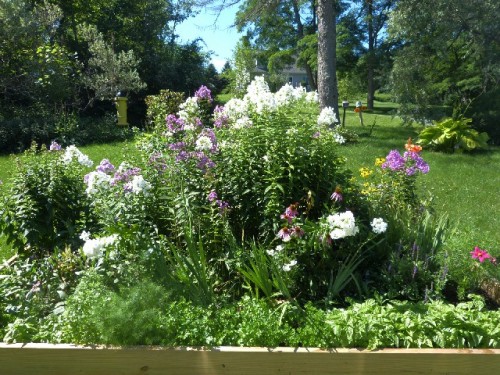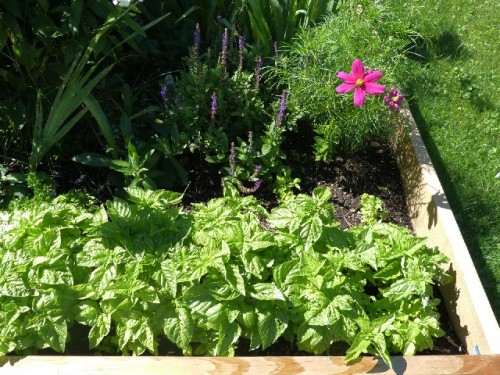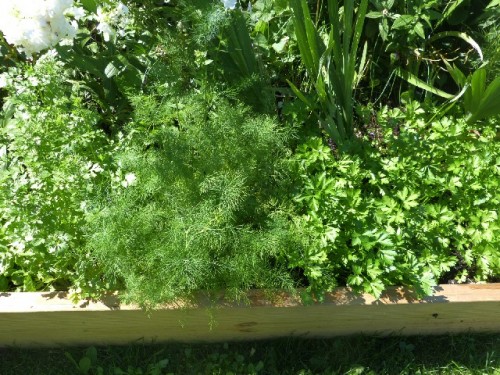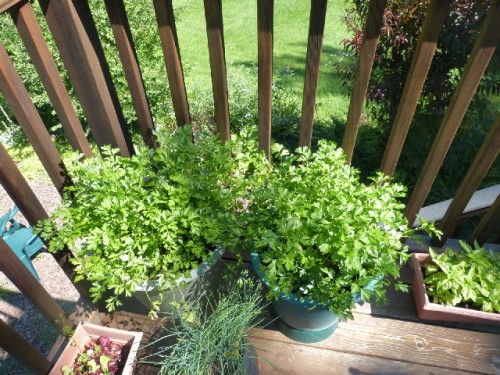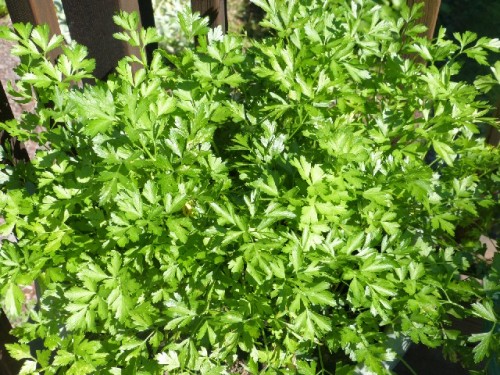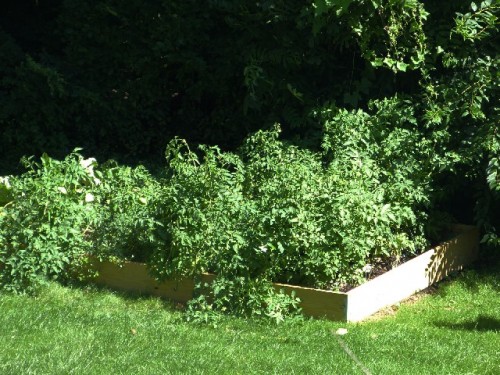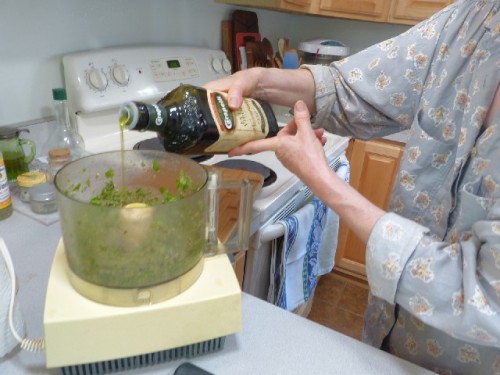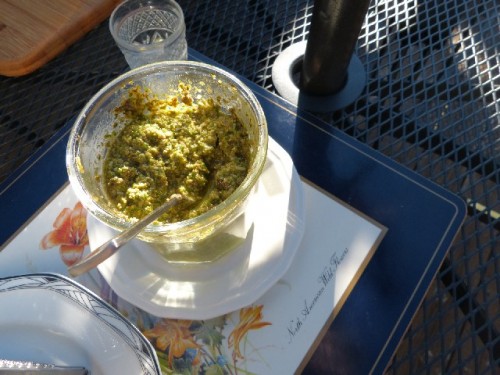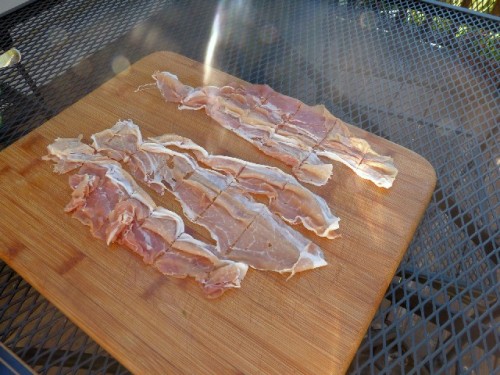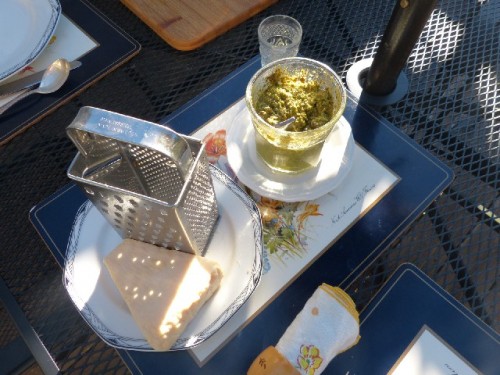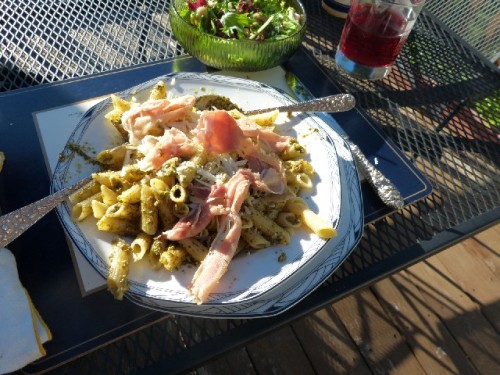Pesto Pasta
Fresh Summer Herbs
By: Charles Giuliano - Aug 11, 2013
As one of ten children of Sicilian immigrants growing up in poverty in Brooklyn my dad described how once a week his mom made the gravy. The Sunday meal perhaps had some chicken or meat and the sauce was thick for the pasta.
For each subsequent meal during the week the sauce grew thinner for the heaping platter of spaghetti. Eventually just a red tint with a touch of grated Romano cheese.
During good times there was meat in the gravy perhaps meatballs or sausage or for special occasions braciole.
Dad visited the butchers in Boston’s Italian North End to get the thin sliced, butterflied, flattened out and pounded steak. Into that went a filling of bread crumbs, grated cheese, chopped parsley, and a couple of sliced, hard boiled eggs.
This was then rolled and tied with string. The bundles of stuffed meat were browned in a frying pan and then put in with the tomato, tomato paste, oregano, thyme, red wine, fried onion and left to simmer over night.
It was like a religious ritual when the braciole was sliced and passed around with sauce and a side of pasta. I have ordered braciole in restaurants and it has never failed to disappoint.
I have suggested to my Italian neighbors- Linda, Liz and Robert- in our artist loft building that we have a braciole bake off dinner party one night. Perhaps this winter. We all have special memories of this special dish.
We were teenagers when my visiting aunt Mary first introduced us to pesto. Our family cuisine is red sauce Sicilian. It is the food that most Americans assume to be definitively Italian. But travel in Northern Italy reveals a vast range of regional cuisine the best of which is found in Bologna, and other than sea food, the worst is Venetian. Unless you are fortunate enough to find the neighborhood trattorias which are fast becoming extinct.
That first exposure to pesto was a life changing culinary experience.
When my sister Pip and I lived within walking distance in Cambridge I liked to cook for her once a week. Sometimes she would be too tired and beg off.
Then I would say the magic word “Pesto” and she would come right over.
The trick was to grow basil in the summer, or buy it from a farm stand, then make pesto to stash in the freezer. Some folks put it into ice trays so they can pop out a cube to flavor a recipe.
It is so precious a winter treat that at times Green Gold can be stashed for years waiting for that special occasion. To my dismay Astrid chucks it out if it gets too old.
Raising basil can be tricky. There are years of crop failure through changes of weather and rain, too much or too little.
Yesterday we had out first batch of the season. The good news is that now that Astrid has found adequate gluten free pasta we can have it more often. That’s a part of the reason why it was stacking up and neglected in the freezer. It’s also great on homemade pizza. Another gluten no no. Although there are gluten free mixes available. Not as convenient as a ball of dough from the super market.
During our years in East Boston the local bakeries sold fabulous fresh dough. That was a kickstarter to great festive dinner parties. With a mix of red and green pies. The pesto pies were definitely the best.
Again, never order pesto in a restaurant. You are sure to be disappointed. They cut corners and you need to make it from scratch from the best ingredients.
Fresh picked basil is absolutely essential. It wilts quickly and looses the precious juices. At best it should be a matter of minutes from garden to blender.
The classic recipe calls for pine nuts. But they are way too expensive.
That’s why we have experimented with all kinds of shelled nuts. Yesterday we used pecans. Walnuts also are good and I like sliced blanched almonds as closest to pine nuts.
My trick is to start with a generous amount of nuts in the blender. Toss in a few pealed cloves of garlic. Taste may vary as to how fine you want the nuts. They can either be processed to a fine paste or left a bit coarser for some texture.
Once the nuts have been processed start to add the best possible quality of extra virgin olive oil. This is critical to the ultimate flavor. To the paste of nuts start adding washed and dried leaves. Stop now and then to scrape the side and add more leaves. When the mixture gets too dry adding more oil changes its texture.
For freezing you might want to leave the mix a bit dry and then refresh the pesto with olive oil when putting it on the table. We like to add a few spoons to a bowl of cooked pasta and then toss it. With more pesto on the table for guests to add to their taste. With fresh grated cheese served at the table.
Yesterday we added sliced pieces of prosciutto. During the summer grilled shrimp or chicken is a nice addition. But you don’t want to overwhelm or distract from the essential impact of the pesto.
This summer our herb garden has done well. We have pots of abundant fresh parsley on the deck and Astrid likes to snip herbs to add to daily salads. In particular we have been using a lot of dill and cilantro as well as the parsley and basil.
I want to experiment with small batches of pesto using some of these other fresh herbs added to the basil. During the dead of winter when parsley is available and basil is not that’s an option for an ersatz pesto.
That first pesto of the season last night was just divine. With more to follow until frost. Then hopefully a stash in the freezer. During the dead of winter there is nothing quite like a pesto dinner to get you through the gloom.
Between now and then mange.

